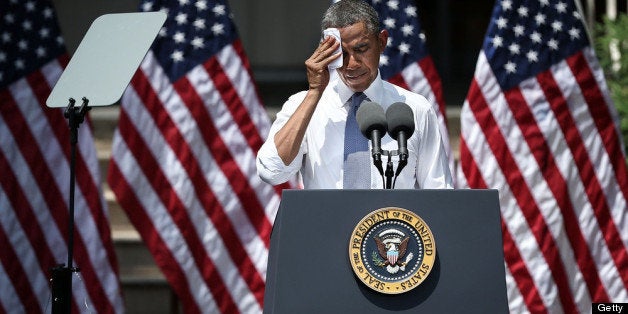
The first national climate plan in the nation's history was issued almost exactly twenty years ago, in October 1993. The Clinton-Gore Climate Change Action Plan (CCAP) contained 44 actions that required no new legislative authority but did, in most cases, require supplemental spending approvals. The programs included several expanded energy efficiency measures, a few small renewable energy programs, methane reduction and forestry actions, and even programs to promote natural gas. Despite calling for spending of about $1.3 billion, the plan was made deficit-negative by proposing to reform a $2 billion tax subsidy for employer-paid parking.

On June 25, 2013, President Obama issued his own Climate Action Plan. The contrasts between this plan and the first attempt in 1993 show how far this issue has progressed and how much President Obama has been able to advance the policy landscape in this vitally important area. It points to significant accomplishments in the President's first term, including a doubling of renewable energy production and a doubling of auto mileage standards, and demonstrates a sweeping command of the issue. In the end, however, it reminds us that we have much more to do, especially in Congress.
Much has been written about the Obama plan's commitment to EPA rules limiting carbon pollution from existing power plants. Although it is quite significant that the president has put his endorsement behind this concept, the rest of the plan is equally significant in many less-recognized ways.
First, the Plan reaffirms the president's commitment to a 17 percent cut in greenhouse gas emissions from 2005 levels by 2020. In spite of the absence of a legislated national policy and an economy-wide carbon price, this goal is within reach. Second, the Plan makes the point that we citizens of the U.S. are already bearing the costs and effects of climate change in the form of increased drought and higher food prices, record-breaking wildfires, and growing super storms and floods. In the last year alone, severe weather events caused $100 billion in damage, the second-costliest year on record. Unfortunately, these severe weather damages are expected to escalate greatly as climate change intensifies.
Many of the specific carbon pollution reductions in the Plan mirror actions in the 1993 plans, but with much greater reach. The Plan sets a goal of doubling non-hydro renewable power generation from today's level of about 4 percent by 2020 and a specific goal of permitting an additional 10,000 MW of renewable plants on federal lands by 2020. To put this in perspective, the total amount of installed non-hydro renewable power in the U.S. in 1993 was only 14,656 MW. For balance, the Plan also announces a new loan guarantee solicitation for carbon capture and sequestration projects of $8 billion, a sum far larger than the entire 1993 plan budget.
Another significant program somewhat buried on the ninth page of the plan is an announcement that the Administration intends to complete new post-2018 mileage standards for heavy trucks. These standards have demonstrated an enormous ability to save fuel costs, reduce pollution, and increase our energy security. The President's single largest first-term energy accomplishment was the industry-accepted increase in passenger car mileage standards to 54.5 mpg by 2025, saving approximately 4 billion barrels of oil and reducing GHG emissions by 2 billion metric tons. While all eyes may be trained on the EPA's power plant rule, these quiet victories form an essential part of a complete national carbon strategy.
In 1993, the idea of adapting our infrastructure to weather the effects of climate change was not a significant part of the policy discussion, and the Clinton plan says virtually nothing about it. The Obama plan contains an entire section on adaptation showing, among other things, that it has absorbed many lessons from its assistance to stricken cities and states in the wake of storms, floods, and droughts. The programs in this area include grants to transit systems and communities to better prepare for floods, programs to help hospitals cope with severe storms, and programs to reduce wildfires and their impacts on rural communities.
Finally, the Clinton-Gore plan predated the Kyoto Protocol and focused almost entirely on unilateral domestic actions. Although there was an acknowledgement that more international work was needed, none of the actions in the plan were focused offshore, and the plan devoted little discussion to international cooperation and agreements.
In contrast, the Obama plan highlights a number of significant international actions, some new and some already underway. The president's recent agreement with Chinese President Xi Jinping to work to reduce especially potent greenhouse gases called hydrofluorocarbons, HFCs, is the most recent international accomplishment noted. In addition, this part of the Plan announces an end to U.S. funding for new overseas coal plants (with some exceptions), one- and six- billion-dollar plans to finance renewables in Africa and the Philippines, respectively, and many other bilateral international actions. These measures are certainly no substitutes for binding international agreements, but neither can the administration be accused of overlooking the importance of international cooperation and action.
All in all, the Obama Climate Plan is vastly evolved from the 1993 CCAP. Given the constraints under which it was developed -- no new legislation or appropriations -- it is a forceful attempt to lay down a marker and make significant progress on all aspects of climate policy. Still, it is not hard to imagine how much stronger the plan would be if Congress could be a willing partner in formulating a full national policy, including a price on carbon in some form. Indeed, if you put the two plans side by side you'll notice a subtle difference between them. The 1993 Plan called itself The Climate Change Action Plan, implying that it was the nation's plan, at least as it was proposed. The Obama plan is called The President's Climate Action Plan; it does not have the seal of the United States on the cover, it has the seal of the White House.
On an issue of this magnitude, it is deeply regrettable that the president and his executive branch must go it alone. The sooner we end this stalemate and join the growing list of countries with national policies and carbon markets the better. Meanwhile, kudos to the president and his team for taking action and elevating the issue greatly on the national and international stage.
DR. PETER FOX-PENNER is a principal and Chairman of The Brattle Group and author of Smart Power: Climate Change, the Smart Grid and the Future of Electric Utilities . The views expressed in this article are strictly those of the author.
Image Sources: "The Climate Change Action Plan," President William J. Clinton and Vice President Albert Gore, Jr., October, 1993; "The President's Climate Action Plan," Executive Office of the President, June 2012.
